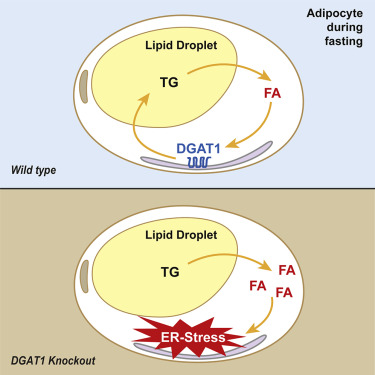当前位置:
X-MOL 学术
›
Cell Metab.
›
论文详情
Our official English website, www.x-mol.net, welcomes your
feedback! (Note: you will need to create a separate account there.)
Triglyceride Synthesis by DGAT1 Protects Adipocytes from Lipid-Induced ER Stress during Lipolysis.
Cell Metabolism ( IF 27.7 ) Pub Date : 2017-Aug-01 , DOI: 10.1016/j.cmet.2017.07.012 Chandramohan Chitraju , Niklas Mejhert , Joel T. Haas , L. Grisell Diaz-Ramirez , Carrie A. Grueter , Jason E. Imbriglio , Shirly Pinto , Suneil K. Koliwad , Tobias C. Walther , Robert V. Farese
Cell Metabolism ( IF 27.7 ) Pub Date : 2017-Aug-01 , DOI: 10.1016/j.cmet.2017.07.012 Chandramohan Chitraju , Niklas Mejhert , Joel T. Haas , L. Grisell Diaz-Ramirez , Carrie A. Grueter , Jason E. Imbriglio , Shirly Pinto , Suneil K. Koliwad , Tobias C. Walther , Robert V. Farese

|
Triglyceride (TG) storage in adipose tissue provides the major reservoir for metabolic energy in mammals. During lipolysis, fatty acids (FAs) are hydrolyzed from adipocyte TG stores and transported to other tissues for fuel. For unclear reasons, a large portion of hydrolyzed FAs in adipocytes is re-esterified to TGs in a "futile," ATP-consuming, energy dissipating cycle. Here we show that FA re-esterification during adipocyte lipolysis is mediated by DGAT1, an ER-localized DGAT enzyme. Surprisingly, this re-esterification cycle does not preserve TG mass but instead functions to protect the ER from lipotoxic stress and related consequences, such as adipose tissue inflammation. Our data reveal an important role for DGAT activity and TG synthesis generally in averting ER stress and lipotoxicity, with specifically DGAT1 performing this function during stimulated lipolysis in adipocytes.
中文翻译:

DGAT1合成甘油三酸酯可保护脂肪细胞在脂解过程中免受脂质诱导的内质网应激。
甘油三酸酯(TG)在脂肪组织中的储存为哺乳动物的代谢能量提供了主要的储存库。在脂解过程中,脂肪酸(FAs)从脂肪细胞TG储存区水解并运输到其他组织以供燃料。出于不清楚的原因,在“无用的”消耗ATP的能量消散循环中,脂肪细胞中的大部分水解FAs会重新酯化为TG。在这里,我们显示脂肪细胞脂解过程中FA重新酯化是由DGAT1(一种ER定位的DGAT酶)介导的。出人意料的是,这种再酯化循环不能保留TG的质量,而是起到保护ER免受脂毒性压力和相关后果(例如脂肪组织炎症)的作用。我们的数据揭示了DGAT活性和TG合成通常在避免内质网应激和脂毒性中的重要作用,
更新日期:2017-08-24
中文翻译:

DGAT1合成甘油三酸酯可保护脂肪细胞在脂解过程中免受脂质诱导的内质网应激。
甘油三酸酯(TG)在脂肪组织中的储存为哺乳动物的代谢能量提供了主要的储存库。在脂解过程中,脂肪酸(FAs)从脂肪细胞TG储存区水解并运输到其他组织以供燃料。出于不清楚的原因,在“无用的”消耗ATP的能量消散循环中,脂肪细胞中的大部分水解FAs会重新酯化为TG。在这里,我们显示脂肪细胞脂解过程中FA重新酯化是由DGAT1(一种ER定位的DGAT酶)介导的。出人意料的是,这种再酯化循环不能保留TG的质量,而是起到保护ER免受脂毒性压力和相关后果(例如脂肪组织炎症)的作用。我们的数据揭示了DGAT活性和TG合成通常在避免内质网应激和脂毒性中的重要作用,











































 京公网安备 11010802027423号
京公网安备 11010802027423号